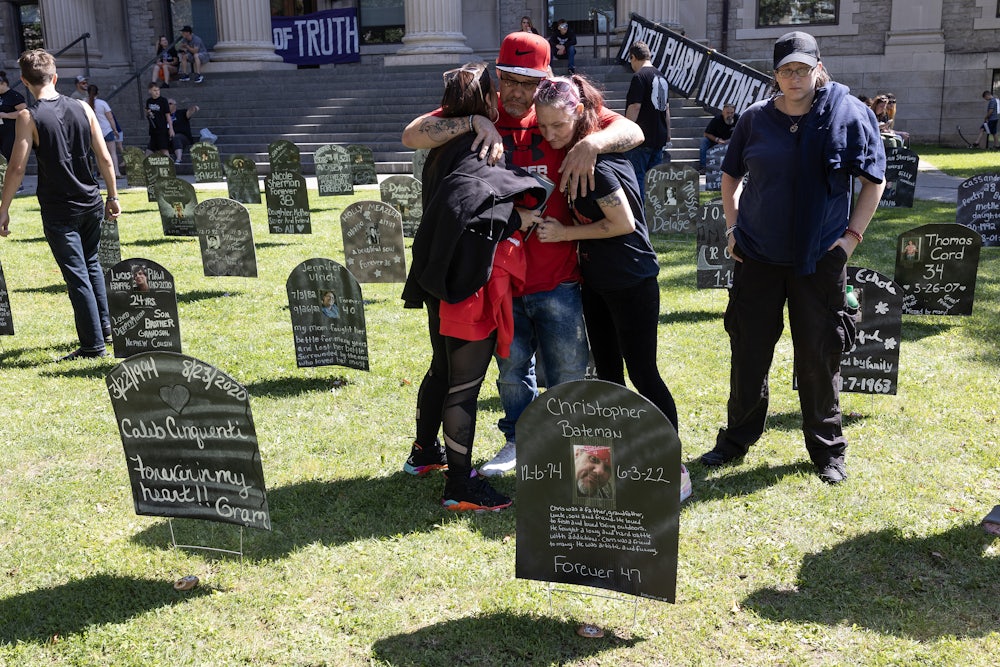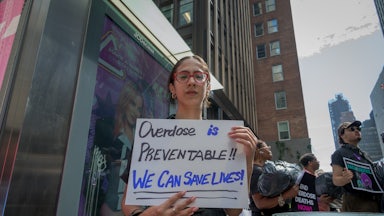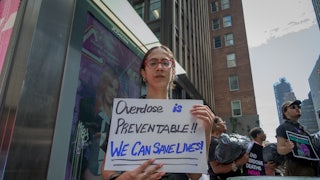Over the past decade, the overdose crisis has killed more than half a million people in the United States. As fentanyl has proliferated, more Americans have shared their own harrowing stories of surviving an overdose—or losing a loved one. From West Virginia to the Bronx, people of all ages and races have tragically had their lives cut short; among them, cherished icons like Prince, the rapper Mac Miller, and actor Michael K. Williams.
A crisis of this magnitude inevitably touches the lives of countless families and communities. This shared grief has helped to push forward public health solutions; the overdose-reversal medication naloxone is now available in many parts of the country, as well as fentanyl test strips. Barriers to addiction treatment have been reduced; federal policy changes now allow patients more flexibility through telehealth prescriptions and take-home dosages of methadone. Syringe service programs have expanded, and the first overdose prevention centers (where overdoses can be reversed by trained staff) have opened in Providence, Rhode Island, and New York City. These are all evidence-based strategies that are proven to prevent overdose deaths and reduce transmissions of infectious diseases like HIV and hepatitis C.
But things are changing, and not for the better. Over the last few years, images of unhoused people on street corners—some of them engaged in public drug use, others struggling with mental health issues—have provoked a backlash that has led political figures, Democrats and Republicans alike, to return to the policies of the crackdown, sweeping encampments away and pushing people into jails.
The current administration has decimated the Substance Abuse And Mental Health Services Administration, or SAMHSA, which awards hundreds of millions of dollars a year in grants for behavioral health care, addiction treatment, and overdose prevention activities. The administration has also changed priorities for housing funding, moving away from a housing-first model to a focus on mandatory drug treatment and work requirements. These actions threaten to make thousands more vulnerable Americans homeless. Public health initiatives to address the nation’s overdose crisis have thus become the victims of a culture war, in which they are seen as “enabling” disorder and crime.
In this environment of competing narratives, what often gets obscured are the economic roots of the crisis. Like many public health issues, the suffering we witness is often the result of financial hardship—communities are left behind, and individuals lack employment opportunities due to a combination of global and local economic factors; plants close and union jobs are lost. Struggling to keep their head above water, people may use drugs or participate in the nation’s unregulated drug economy, thus getting caught up in an unforgiving cycle of addiction and financial hardship.
Research has shown that there is a link between unemployment, opioid use, and overdose. Two studies conducted by researchers at UCLA, for instance, found a 40 percent higher chance of problematic opioid use among those who are unemployed compared to those who work 35–40 hours a week. As the U.S. loses manufacturing jobs, overdose rates in areas that have seen such losses tend to be higher. One study looked at the period from 1999 to 2015, in which the U.S. lost two million jobs due to international trade. The study found that the loss of 1,000 trade-related jobs in an area resulted in a 2.3 percent increase in overdose deaths—and when fentanyl was present in the area’s drug supply, it skyrocketed to 11.3 percent.
A study funded by the Social Security Administration also found that increases in exposure to automation is responsible for 12 percent of the rise in overdoses from 1993 to 2007. Finally, a study published by The Journal of the American Medical Association found that overdose deaths spiked by 85 percent after closures of automobile assembly plants in the American South and Midwest, with the largest increases among non-Hispanic white men.
It’s not just losing your job, but the type of job you work that puts people at high risk for overdose. Certain occupations have higher rates of overdose deaths than others, according to the Centers for Disease Control and Prevention. These include construction and heavy extraction industries, food preparation and service sectors, building and grounds maintenance, and transportation and moving. All of these job classes are associated with lower wages or require a high amount of manual labor. Someone could turn to substance use to deal with the stress of losing a job, or they could begin using drugs to deal with the pain from an injury suffered at work.
Increased drug use and overdose rates often occur after a disruptive event. On a national scale, the Covid-19 pandemic spiked overdose deaths to over 100,000 a year for three years. On the individual level, the loss of a job or being evicted can serve as disruptions. Research from the past two decades has shown evictions are associated with increased overdose deaths. One study looked at county-level eviction rates and drug mortality rates from 2003 to 2016 and found that high levels of evictions were associated with increased mortality rates for six types of drugs, including opioids. A more recent study from our research team in Rhode Island showed that census tracts with the highest rates of eviction also had the highest rates of overdose, but when an eviction moratorium was implemented briefly during the pandemic, this relationship was no longer significant.
Evictions also lead to homelessness, which is strongly linked with higher rates of overdose deaths. As we know, some unhoused people find shelter, community, and safety by living in an encampment and when these are cleared, it serves as a disruptive event by severing people from social ties and critical services—once again leading to increased overdose deaths.
While poverty pushes people into conditions where overdose risk is heightened, it also pushes people to participate in the dangerous and unregulated drug market. Last year, The New York Times published a piece about Americans who smuggle fentanyl across ports of entry—among them, a homeless man recruited from a Walmart parking lot and a single mother of three kids facing eviction. The piece explains how cartels recruit from trailer parks and rehab facilities, among other places. Often, there is a false dichotomy between those who sell drugs and those who use drugs: In actuality, a significant number of people who sell drugs are also users.
Whether someone is selling or using, once they are caught up in the criminal justice system, there is a litany of consequences that further perpetuates poverty and overdose risk. For instance, there is currently a federal ban on accessing Supplemental Nutrition Assistance Program benefits, known as food stamps, if you have a drug-related felony. However, this can be waived by states. Employment and housing are also hard to secure with any criminal record, let alone a drug-related conviction. All of this, coupled with a drug supply that is constantly changing, makes recently incarcerated people one of the highest-risk groups for overdose death. They are over 40 times more likely to die compared to the rest of the population, a third of those deaths occurring within 24 hours of release.
A lack of stable housing, unemployment, work-related injuries, and incarceration provide different and intersecting pathways through which overdose death can occur. This suffering is made worse through acts of corporate malfeasance. By now the country is well acquainted with how Purdue Pharma and other pharmaceutical companies deceptively marketed OxyContin and other potent opioids, often with the help of firms like McKinsey and Company. Thousands of people got addicted to opioids and ended up transitioning to heroin (and later fentanyl) when stricter prescription controls were implemented.
But there is a broad constellation of lesser players adding fuel to the fire. When seeking treatment, people may be caught up in fraudulent treatment providers and rehabilitation centers that take their money and leave them without care. Meanwhile, legitimate opioid treatment providers are being gobbled up by private equity (which currently owns a third of methadone clinics nationally), but with no real expansion of methadone treatment. When legislation was proposed last year to have methadone dispensed at pharmacies, for-profit and private equity–owned opioid treatment providers opposed the legislation because it would create competition for their businesses.
Overdose deaths have declined in the past two years in part due to the public health interventions that have been implemented over the past decade. But deaths remain stubbornly high, and people still have frustrations over what they see on the street—the fact is, these overdose prevention services are the last line of defense when the social safety net has failed. Outreach workers work hard to help keep people alive, but when there is no housing available, when treatment remains out of reach, and jobs are hard to come by, there will continue to be visible homelessness and drug use.
Now the situation could
get dramatically worse. For the first time in decades, the financial
position of coming generations could
be worse than their predecessors’. Research from
counties in the Midwest has shown that declining intergenerational income
mobility is associated with increases in overdose deaths. Unemployment
is increasing every month, and the cost of living continues to go up.
Rents continue to increase across the U.S., and wages
are not keeping up with people’s costs. More and more Americans are working
multiple low-paying jobs and experiencing
homelessness.
On top of all that, without congressional intervention, many people will soon face
an increase in their ACA-provided coverage and many others will be pushed out
of Medicaid, which provides most of the coverage for opioid treatment in the U.S.
Medicaid recipients have
twice the risk of overdose death compared to the general population. With
all of these crises piling up, addiction and overdose prevention services with
shoestring budgets are under attack and are facing existential crisis with
budget cuts and changing federal priorities.
To really stem this crisis and improve public health, the country must pursue an aggressive campaign of economic justice. Studies consistently show that if people are paid good wages and can afford the necessities in life, if they aren’t worried about the costs of health care or about getting priced out of their neighborhood, then they will be able to thrive and be less likely to fall victim to an overdose or experience other health problems.
While these next few years will prove to be challenging, there are some small steps that can be taken. Congress can finally pass bipartisan legislation to eliminate the SNAP drug felony ban, which some states have eliminated already. One study found that states that eliminated the ban had lower rates of alcohol and substance use disorder compared to states that did not.
In terms of housing, localities can do much more. Past work has shown that eviction moratoriums did reduce overdose death rates (and conversely, lifting them increased deaths). Even though the Trump administration is abandoning Housing First policies, states and cities can invest in building affordable housing and providing rental assistance. To ensure people with criminal records are not discriminated against in housing and employment, cities can pass ordinances such as the ones in Atlanta and San Francisco. Atlanta’s ordinance makes being formerly incarcerated a protected class, while San Francisco has a fair-chance ordinance that restricts consideration of criminal records in hiring decisions.
To expand access to treatment, states can change their Medicaid policies to allow for the coverage of medications for opioid use disorder, or MOUD—which results in a 70–80 percent higher utilization of MOUD by people who use drugs compared to people in states without coverage.
But perhaps most importantly, cities and states should pursue any policy that provides financial assistance. One study that examined the time period of 2014–2020 found that areas with higher unemployment benefit amounts had lower rates of overdose deaths; other studies have found similar results. Research looking at the time of the Great Recession found a 1.3 percent decrease in per capita prescription opioid use for every $10,000 increase in unemployment benefit levels. Clearly, providing people with economic support works.
The United States can build on the progress made recently in reducing overdose deaths by addressing the root economic causes of such suffering; by embracing economic populism rather than scapegoating effective public health measures, policymakers can chart a better way forward. Even if the current political conditions at the federal level are unforgiving to these policy interests, this is nevertheless the time to be bold and imaginative wherever possible. After all, millions of lives hang in the balance.










